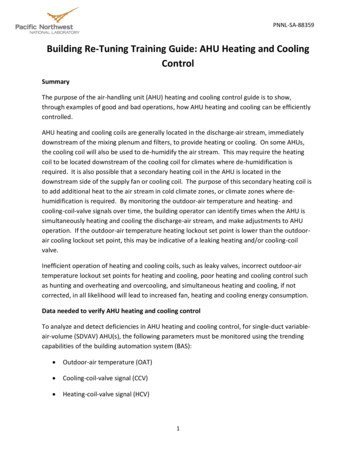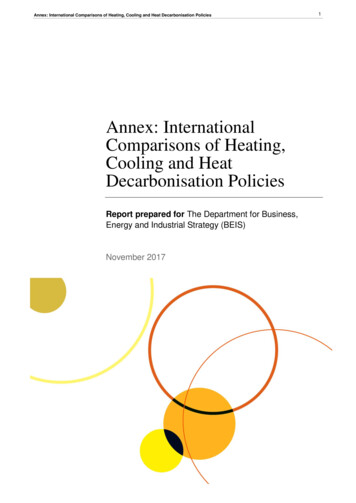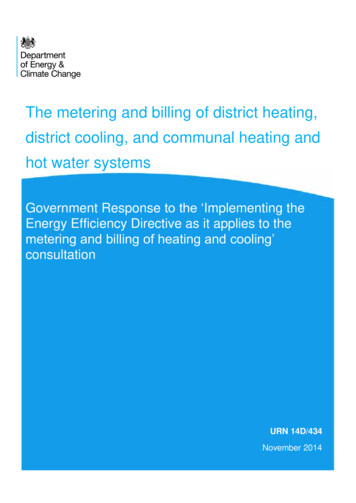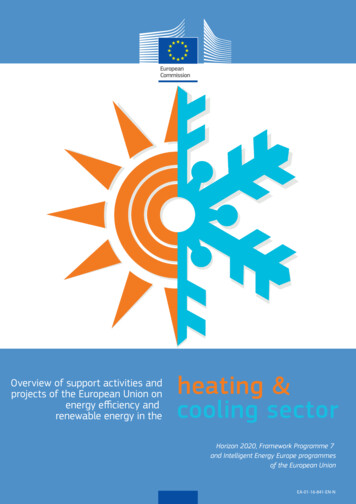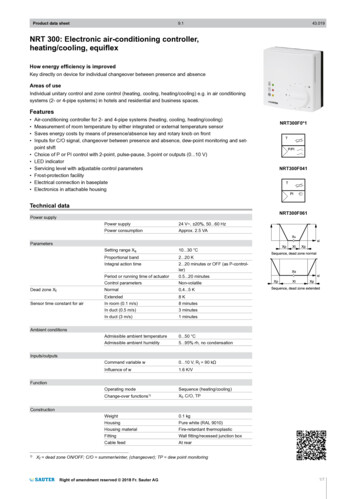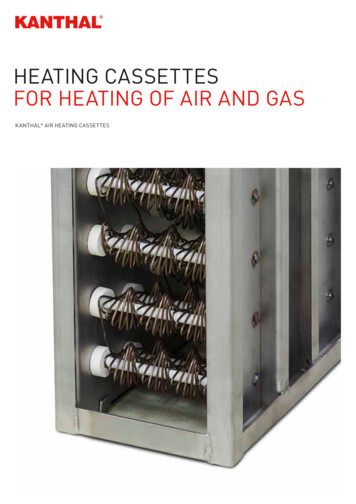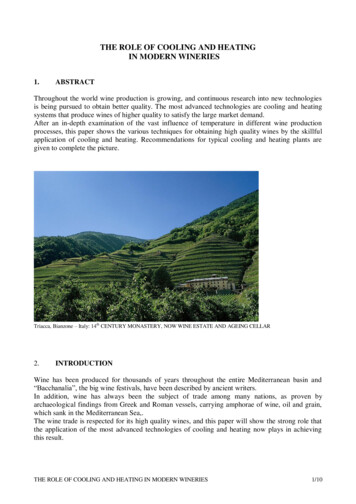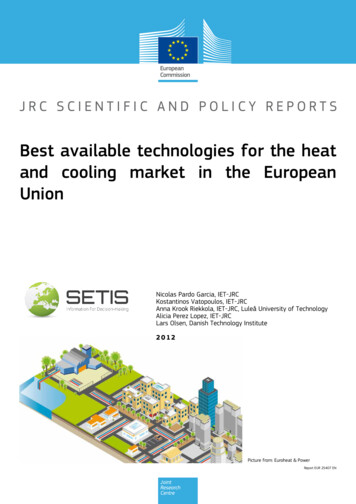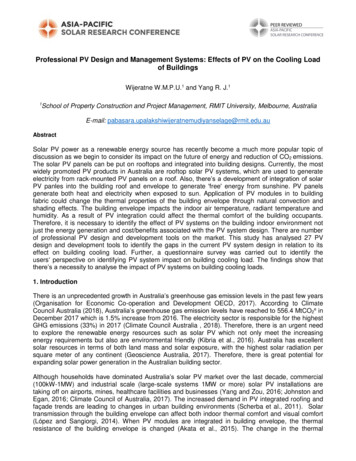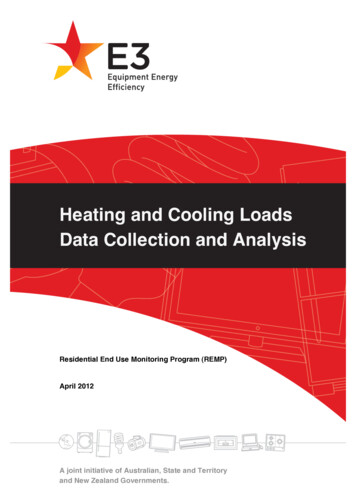
Transcription
Heating and Cooling LoadsData Collection and AnalysisResidential End Use Monitoring Program (REMP)April 2012A joint initiative of Australian, State and Territoryand New Zealand Governments.
Commonwealth of Australia 2012This work is copyright. Apart from any use aspermitted under the Copyright Act 1968, no partmay be reproduced by any process without priorwritten permission from the Commonwealth.Requests and inquiries concerning reproductionand rights should be addressed to the:Commonwealth Copyright AdministrationAttorney General’s DepartmentRobert Garran Offices, National Circuit BartonACT 2600or posted at:http://www.ag.gov.au/ccaThis Report is available atwww.energyrating.gov.auWhile reasonable efforts have been made toensure that the contents of this publication arefactually correct, E3 does not accept responsibilityfor the accuracy or completeness of the content,and shall not be liable for any loss or damage thatmay be occasioned directly or indirectly throughthe use of, or reliance on, the contents of thispublication.REMP: Heating and Cooling Loads Data Collection and Analysis2
ContentsCONTENTS. 3EXECUTIVE SUMMARY . 41. INTRODUCTION . 71.1 Scope of End-use Measurement - Why it is Important. 72. CURRENT UNDERSTANDING OF SPACE CONDITIONING . 102.1 Ownership – Space Cooling Equipment . 102.2 Ownership - Space Heating Equipment . 112.3 Use . 122.4 Technology . 142.5 Seasonality.152.6 User Interaction .153. KEY ISSUES. 174. STRATEGY FOR MONITORING . 194.1 What Surveys (physical, social). 194.2 Specifically What to Monitor .204.3 Equipment: What to Record .205. CONCLUSIONS AND RECOMMENDATIONS FOR MONITORING. 215.1 Recommendations . 216. LESSONS FROM THE REMP PILOT . 226.1 Pilot Data . 237. REFERENCES . 26APPENDIX 1: ACCURATE THERMAL STIMULATION MODEL – MAIN INPUT REQUIREMENTS. 27APPENDIX 2: SURVEY INSTRUMENT. 28APPENDIX 3: OUTPUTS AND ANALYSIS. 30LIST OF TABLESTable 1: Typical conversion efficiencies by space conditioning technology type . 14LIST OF FIGURESFigure 1: Space Conditioning Energy Use By Fuel Type – Australia 2010. 8Figure 2: Trends in space conditioning energy use – Australia .8Figure 3: Ownership Trends for Air Conditioners in Australia . 10Figure 4: Share of Air Conditioner Stock by Type in Australia. 11Figure 5: Ownership Trends for Space Heaters in Australia . 12Figure 6: Residential Occupancy Profiles – Australia . 13Figure 7: Cooling Loads Associated With Various Thermostat Settings – Detached Dwellings in Adelaide. 16Figure 8: Use of Air Conditioner over Summer – REMP House 2 . 23Figure 9: Illustration of Peak Load Composition on a Hot Day – REMP House 2 (60 min av) . 24Figure 10: Illustration of Peak Load Composition on a Hot Day – REMP House 2 (10 min av). 25Figure 11: Illustration of Peak Load Composition on a Hot Day – REMP House 2 (1 min av). 25REMP: Heating and Cooling Loads Data Collection and Analysis3
Executive summaryThis paper is one in a series of papers on end-use metering methodologies, prepared to assist in the developmentof end-use metering campaigns. The full suite of papers covers: Residential End Use Monitoring Program (REMP) – General Introduction and Overview;Residential End Use Monitoring Program (REMP) – Water Heating Data Collection and Analysis;Residential End Use Monitoring Program (REMP) – Lighting Data Collection and Analysis;Residential End Use Monitoring Program (REMP) – Heating and Cooling Loads Data Collection and Analysis;(this paper) Residential End Use Monitoring Program (REMP) – General Plug Loads Data Collection and Analysis; Residential End Use Monitoring Program (REMP) – Equipment Recommendations; Residential End Use Monitoring Program (REMP) – Data Management Strategy: Data Handling and DatabaseRequirements/Specifications.Each of those papers contains recommendations that are specific to those end uses or elements. This papercontains general information and recommendations that are applicable to space heating and cooling.The Australian Government is considering end-use metering campaigns to fill various gaps in its knowledge,especially relating the important residential end-uses. These papers will be used to set out requirements for apossible future tender.The purpose of the paper is to provide background information and guidance regarding end use metering for spaceconditioning equipment. As space conditioning use is dependent upon building shell performance, this aspect isalso covered in this paper.This paper examines: The scope of space conditioning use in Australian households; Existing energy policy relating to this end use; Details of the current state of knowledge in respect of space conditioning equipment ownership, use,technologies as well as their impacts of seasonality and user interaction; Key issues for consideration in relation to monitoring this end use; Monitoring strategies, expected outputs and analysis.Space conditioning constitutes the largest single energy use in the average Australian household accounting for40% of total energy consumption in 2010 (EES 2008). Demand for heating and or cooling varies significantlyaccording to climate. Nationally, energy demand for heating exceeds that for cooling by a factor of approximately10 but space cooling is still significant, particularly because of its potential to create major problems for theelectricity generation transmission and distribution system on days of maximum (peak summer) demand. Inenergy terms, cooling loads are dominant in Queensland and Northern Territory, but most other states andterritories tend to be heating dominated (much of NSW has roughly equal heating and cooling loads). Most heatingloads are supplied by fuels other than electricity. Nevertheless, in most jurisdictions it is the summer peak loaddriven by residential air conditioning that is of most concern, and the growth of this peak is the cause of very highlevels of transmission and distribution investment, and therefore growth in electricity cost to consumers.Governments at both state and federal level have, over the past 20 years, introduced a number of energy efficiencyprograms including energy labelling and MEPS to improve the performance of the more common forms of spaceconditioning equipment and the building shells in which they operate.Demand for space conditioning is dependent upon a complex mix of factors, including: Climate (and to some extent weather);Building shell performance, building size and configuration;Capacity of space conditioning equipment, and the area of the house conditioned;Conversion efficiency of space conditioning systems;REMP: Heating and Cooling Loads Data Collection and Analysis4
User behaviour in terms of rooms conditioned, hours of use and thermostats. This is often influenced by thenumber of residents; Household income and education levels (demographic data - this information should be gathered in a separatequestionnaire), which can influence expectations of comfort and conservation behaviour; Heat loads generated by equipment within the dwelling (only an issue during when there is a coolingrequirement, generally these heat loads are relatively small; monitoring of other equipment is covered inseparate papers).The complex interactions between these factors mean that modelling exercises designed to estimate likely demandoften feature a high degree of uncertainty. Part of the aim of this monitoring program will be to better understandthe interaction of these factors and hopefully reduce the uncertainty associated with the modelling of spaceconditioning energy consumption in the future.Some of the key issues that present major challenges with respect for monitoring of space heating and cooling are: Establishing the field performance characteristics of the space conditioning equipment and their peripheralssuch as ducting, fans, pumps etc; Conversion of metered energy data into heating and cooling output (as this cannot be directly measured in situ); Monitoring of certain types of space conditioners such as solid fuel burners; Accounting for the seasonal nature of space conditioning; Integrating real weather data (Bureau of Meteorology) into the data set for the monitored house (includinglocally measured outdoor temperatures); Assessing and integrating building shell performance data (for the initial pilot houses door blower tests andFirst Rate assessments were carried out well before the installation of REMP equipment). The need for this levelof assessment in future measurement exercises should be evaluated, but recognising the capacity of suchmonitoring to improve AccuRate modelling, it is probably essential1. Monitoring occupancy, which can significantly impact on use2; Monitoring/assessing certain user behaviours that can impact on space conditioning use such as zoning (plantmay not have the capacity to condition all rooms and users may not chose to condition all rooms that can beconditioned), use of curtains, blinds and window openings, clothing strategies etc. recognising that such aspectspresent difficulties in terms of objective measurement; Quantifying key drivers for use of space heating and cooling equipment (eg occupancy, trigger temperatures foroccupants to turn on equipment, demographic factors); Recognising that user related behaviour can be highly variable from day to day and from house to house (incombination with the above factors) and undertaking further analysis to explain these variations and developmethods to better characterise these effects (recognising that these are best treated as distributions rather thansimple averages).Survey data collection during end use monitoring needs to include: Technical details of all space conditioning equipment; Questionnaire information relating to zoning practices and use of thermostats, openable windows, fans, windowcoverings and even clothing strategies; A physical survey of the building shell to establish its thermal performance properties; Weather data from the Bureau of Meteorology (BOM3).The raw monitoring data will need to take the following form: Time-based electrical energy (Wh or average W);Time-based gas consumption of gas space conditioning equipment;On/off event times for space conditioning equipment (heating and cooling);Time-based binary information for room occupancy;Time based data on internal room temperature;Time based data on internal humidity;The cost of modelling plus blower door test is small compared to the total cost of 12 months of energy monitoring. Ultimately, one goalof further house energy modelling and end use metering should be to improve and validate building shell modelling to the point where itis universally recognised as the most cost effective approach to improved house energy performance.2 Options for large scale assessment of occupancy should be examined (eg television viewing data may provide useful information).3 The Bureau of Meteorology collect a wide range of data on weather. Compilation of this data ex post is required to run AccuRatesimulations for the actual weather during the period of end use monitoring. Generally it is not possible to locally collect all localparameters required for building simulation.1REMP: Heating and Cooling Loads Data Collection and Analysis5
Time based data on external temperature; Time based data on external humidity;The main monitoring will provide data on the following parameters: Hours of use (Daily);Time of day of use;Energy consumption per home (including time of day analysis);Space conditioning service levels (primarily temperature, but also humidity);Room occupancy (where passive infra red sensors are used);Prevalence and proportion of plug load space conditioners.When monitoring data is coupled with data from surveys, the equipment inventory and building shell, moresophisticated analysis can be undertaken, such as understanding energy consumption as functions of othervariables such as climate, floor area, income, occupancy profile, user behaviour and building shell performance.This is examined in more detail in the paper and could be used to calibrate and fine tune the use of building shellmodels for energy policy and planning purposes.A brief discussion on the lessons learnt from the REMP pilot project is outlined in this paper as well as an overviewof some of the plug load data captured by this project.REMP: Heating and Cooling Loads Data Collection and Analysis6
1. IntroductionThis paper is one of a series of papers on energy end use measurement that have been prepared for the Departmentof Climate Change and Energy Efficiency (DCCEE) in relation to the Residential Energy Monitoring Program(REMP).The purpose of the paper is to provide background information and initial recommendations regarding how spaceconditioning equipment should be surveyed and monitored in an expanded REMP program. Space conditioninguse is critically dependent upon building shell performance, so this aspect is also covered in this paper. This paperhas been reviewed in the light of the REMP pilot monitoring experience and is being used as the basis for a detailedmethodology paper for the measurement and analysis of heating and cooling loads.The paper provides general information on residential space conditioning and examines data collection strategiesthat can maximise the information on space conditioning usage, system and building shell performance duringnormal use. This paper examines issues surrounding the in-situ measurement of space conditioning energyconsumption and building shell performance and provides guidance on the parameters that should be monitoredas part of an end use measurement program in order to obtain a sufficiently accurate understanding of the natureof space conditioning energy use and the energy implications for different types of space conditioning technologiesand building shell performance characteristics.1.1 Scope of End-use Measurement - Why it is ImportantSpace heating and cooling equipment in Australian homes is estimated in 2010 to account for 40% of total energyconsumption. Significantly, 37% of all energy used is associated with space heating and 3% associated with spacecooling (EES, 2008). Whilst the cooling energy component is relatively small, cooling loads are significant due totheir very poor load factor and potential to create major problems for the electricity generation transmission anddistribution system on days of maximum (peak summer) demand. In addition, cooling energy is projected toundergo significant growth ( 32%) over the next 10 years, compared with a 13% growth for heating energy (EES,2008).Whilst space cooling utilises electricity only, space heating utilises a variety of fuel types. The most significantbeing natural gas, electricity, firewood, and LPG (see Figure 1). Space conditioning accounted for practically allwood use in Australian homes, 61% of all natural gas use, 44% of all LPG use and 13% of all electricity use in 2010(EES 2008).A range of factors is expected to drive increased growth in space conditioning energy consumption over the next 10years (see Figure 2). Despite improvements in new dwelling energy efficiency standards since 2003, the mainfactors influencing growth are: Increasing number of households; Increasing average floor area of dwellings, though there is evidence of a plateau, in part due to smaller blocksizes; Higher standards of comfort demanded by householders; Low cost and growing ownership of air conditioning equipment.REMP: Heating and Cooling Loads Data Collection and Analysis7
Figure 1: Space Conditioning Energy Use By Fuel Type – Australia 2010Source EES 2008Figure 2: Trends in space conditioning energy use – AustraliaSource EES 2008. Actual weather used to 2004.REMP: Heating and Cooling Loads Data Collection and Analysis8
Making sense of heating and cooling energy end use measurements in dwellings presents a range of specialproblems not encountered for other end uses. The main issues are: Measurement of input energy alone does not give a good indication of output heating or cooling service levelsfor most heating and cooling equipment. Information on the performance (such as output and efficiency) of theproduct under normal conditions of use needs to be available before input energy consumption can be used toestimate output energy into the home – this is sometimes hard to obtain for appliance without an energyefficiency rating scheme or for those parts of the appliance not covered by the scheme (such as ductwork) or forconditions that are far from standard rating points; Building shell thermal performance has a very strong influence on internal environmental conditions andtherefore the use of heating and cooling equipment to maintain comfortable conditions; Real weather conditions are highly variable in the short term and this will affect usage on an hourly basis –there are also strong seasonal effects over a year, which makes short term monitoring quite problematic andgenerally irrelevant, particularly in climates with strong seasonal variations (some dwelling designs will performwill in one season and poorly in comfort terms in another. Modelling can be used to extend understanding ofmeasurements); A range of social and behavioural factors can have a very strong affect on the requirements for and operation ofheating and cooling equipment:— Occupancy – people are often out of their homes for extended periods (40% of households are unoccupiedduring normal working hours (EES 2008)) – typically dwellings are not space conditioned when the buildingis not occupied (although this is not always the case);— Zoning – often heating and cooling equipment is designed to ‘condition’ only a limited part of the house(typically the living area), and there may be multiple systems around the home that are operated as required.In addition there may be cases where an undersized space conditioning unit is unable to cool or heat morethan just the living room. Complete space conditioning is relatively rate in the Australian housing stock, butis a growing trend in new houses;— Users have different thresholds regarding thermal comfort (even within the one house), this impacts on theinitiation of operation of their systems and the thermostat setting selected;— Other building shell elements, such as curtains, blinds, openable windows, external shutters or blinds, can beused by occupants to control heat transfers into and out of the dwelling. Fans can also be used to altercomfort conditions. Components that are peripheral to space conditioning equipment can impact on space conditioning systemenergy losses. The effectiveness of ducting and other delivery mechanisms can account for losses of 20% to40%; There are also some problematic fuel sources such as LPG4, oil, wood and other solid fuels, although most ofthese (apart from wood) are now fairly uncommon in Australian homes, particularly in urban areas. Theirpresence in a home that is selected for end use metering can cause major problems as there technical problemsin determining either input or output energy from these sources.Looking at usage and resulting energy consumption of the space conditioning equipment in isolation is of littlevalue in understanding how overall energy can be reduced through improved equipment, more efficient buildingshells and how user comfort and other factors influence usage. Households may have the same space energy inputbut have very different options for reducing this energy use depending on the efficiency of the appliance andbuilding shell, and the comfort requirements of the occupants.It is technically possible to meter LPG energy using a modified gas meter, but installation of such a meter could result in significantmodifications to the pipework or in some cases may not be feasible.4REMP: Heating and Cooling Loads Data Collection and Analysis9
2. Current Understanding of Space Conditioning2.1 Ownership – Space Cooling EquipmentThe main forms of space cooling equipment installed in Australian dwellings include: Air conditioners reverse cycle non-ducted (room type systems);Air conditioners cooling only non-ducted (room type systems);Ducted air conditioners ducted (includes cooling only and reverse cycle types);Evaporative air conditioners (mostly central5).Room type systems include both window wall types and split systems.Air conditioner ownership accelerated rapidly after 2000 in most states, noting that ownership differssubstantially by state. A summary of national ownership trends and share by type is shown in Figure 3 and Figure4 Non-ducted reverse cycle units are now the most common type and account for about 65% of total sales (mostlysplit systems – window/wall units are now rare) and this share is expected to increase to over 80% by 2020 (EES2008). Existing energy labelling and MEPS programs cover these products.Figure 3: Ownership Trends for Air Conditioners in AustraliaSource EES, ABS26025ABS4602-2008 reports that over 75% of all evaporative systems were central ducted.REMP: Heating and Cooling Loads Data Collection and Analysis10
Figure 4: Share of Air Conditioner Stock by Type in AustraliaSource EES, ABS46022.2 Ownership - Space Heating EquipmentThe main forms of space heating equipment installed in Australian dwellings include: Electric resistive space heating (including portable heaters);LPG gas non-ducted space heating;Mains gas ducted space heating;Mains gas non-ducted space heating;Reverse cycle ducted space heating;Reverse cycle non-ducted space heating;Wood space heating (both open and closed combustion).Space heating ownership and type differs substantially by state. One important factor is the availability of fuel type– reticulated natural gas is common in Victoria, South Australia, Western Australia (in capital cities at least) andmore recently in the ACT, it is less common in NSW (50% of household gave gas in Sydney, 25% for the balance ofNSW), and unusual in Queensland, Tasmania and the Northern Territory (10% of less of households). Queenslandand the Northern Territory have generally low heating requirements and these two states have a significantproportion of households with no main space heating (as recorded by ABS, although they are likely to use somesecondary heating, which would most commonly be portable electric resistive heaters).Figure 5 sets out national trends on space heating ownership by type. Gas heating is increasing, but gas is alreadydominant in most of the colder climates (except in Tasmania), so it accounts for the bulk of national heatingenergy. Electric space heating is increasing, mostly in the form of reverse cycle air conditioners, generally in thestates with milder climates (and especially in those areas without reticulated gas).REMP: Heating and Cooling Loads Data Collection and Analysis11
Figure 5: Ownership Trends for Space Heaters in AustraliaSource EES, ABS4602Note: Electric heating includes resistive heating and reverse cycle air conditioning (all types).2.3 UseIn most households space conditioning use is to some extent discretionary6. Such use is influenced by a number ofkey factors as follows:Ownership of Space Conditioning Equipment – The application of space heating and or space cooling isnaturally dependent upon the household’s ownership or otherwise of space conditioning equipment. For instance,in 2011 it is estimated that approximately 73% of households in Australia own a space cooler. This means that for asignificant proportion of dwellings there will be no use of space cooling despite the fact that comfort conditionsmay not be met. For details relating to space conditioning equipment ownership refer to section 2.1.Occupancy – Unlike an appliance such as a refrigerator, which operates continuously, most households operatetheir space conditioning equipment only when the dwelling is occupied and only when required. Occupancy willvary according to the household make up. Analysis of ABS time use survey data (EES 2008) shows varying degreesof occupancy (at least one occupant in residence) according to the time of day and the day of the week (Figure 6).Lower occupancy rates during daylight hours are important in constraining demand for space cooling. Long termsocial and demographic changes are expected to impact on occupancy profile trends (eg the aging of the populationand the trend to home based work may both increase occupancy during the day and the level of comfort required).6This is unlike Scandinavia, for example, where you would die with no space heating in winter.REMP: Heating and Cooling Loads Data Collection and Analysis12
Figure 6: Residential Occupancy Profiles – AustraliaSource EES 2008Climatic Conditions – Ambient conditions will significantly impact on internal comfort conditions (dependingon the efficiency of the building shell), and as a consequence, climatic conditions are a significant determinant ofspace conditioning use. Climate naturally varies according to geographical location, ranging from heatingdominated climates in the south of the country to cooling dominated in the north.In addition, weather varies year to year for a given location. This means that average climate conditions for aparticular location (as may be used in thermal simulation software), whilst useful for comparative purposes,cannot be assumed to be representative of the prevailing weather at the time that end use measurements aretaken7.Building Shell Thermal PerformanceA well designed and constructed building shell (appropriate to the particular climate) can significantly reduceheating and cooling loads to be met by the installed space conditioning equipment. A six star NatHERS ratedbuilding shell will require only one third the energy input to maintain equivalent comfort conditions compared to a2 star NatHERS rated dwelling of the same size, all other factors being equal. Many newer dwellings may comewith ratings based on construction plans and specifications. However, it is important that the “as built” conditionsare checked, recorded and used for simulation purposes rather than relying on claimed specifications alone.The key physical factors that impact upon the thermal performance of a residential building shell are: Insulation to ceilings, walls and to a lesser extent floors, and any ga
40% of total energy consumption in 2010 (EES 2008). Demand for heating and or cooling varies significantly according to climate. Nationally, energy demand for heating exceeds that for cooling by a factor of approximately 10 but space cooling is still significant, particularly because of its potential to create major problems for the

